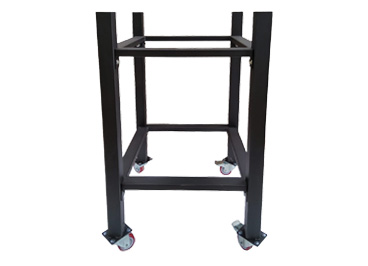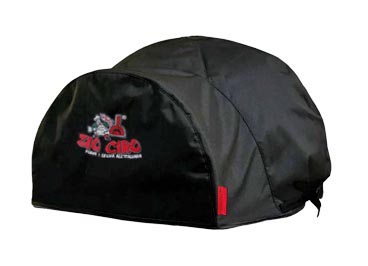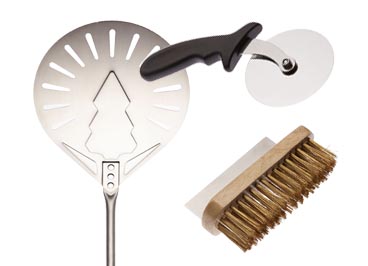Designed and Made in Italy with love
Menu
Curing is the process by which your oven is gradually and uniformly dried out of the humidity that might have been accumulated in the oven during the building and assembly stages.
During the process of heating up, thermal expansion occurs, and to maintain the same rate of expansion and to prevent structural cracks, the materials need to be as dry as possible.
Small hairline expansion lines are normal and will not affect the performance of your oven, while larger, structural cracks could diminish its efficiency and cause issues down the road, so this is a step you do not want to skip or rush through!
While curing fires do not need to occur on consecutive days, best results have been achieved with no more than two days between heat cycles.
Your oven will release water during curing, when it does keep the temperature steady until it stops and then resume your curing fires.
From the technical standpoint, water will be expelled until the entire oven has reached 350 degrees C. for 3 or 4 times, so it is not unusual to see water even after several fires. As you cure you might see small expansion lines, they are normal, but are exasperated by too much heat too soon, so always bring your oven to temperature gradually.
If your oven was ever to suffer from water infiltration, let it dry completely for at least 7 days, (you can use a small space heater to decrease the humidity) and then cure again. We also recommend a mini curing after prolonged periods of inactivity, and should you be using your oven during the winter months a gentle heating up to prevent thermal shock.
IMPORTANT-WARNING READ ALL INSTRUCTION CAREFULLY BEFORE INSTALLING AND USING YOUR SUBITO COTTO OVEN. FAILURE TO FOLLOW INSTRUCTIONS MAY RESULT IN PROPERTY DAMAGE, PERSONAL INJURY OR EVEN DEATH
How to assemble our ovens
Powering, cleaning and upkeep
Discover technical certifications
How to assemble our ovens
Powering, cleaning and upkeep
Technical certifications

HEADQUARTERS
White’s Foodservice Equipment
Unit 8, Padgets Lane, Redditch,
Worcestershire B98 0RA
Email: info@zio-ciro.co.uk
Phone and WhatsApp : 01527 528841
From a young age, Zio Ciro learned the art of pizza-making from his Nonna Rosa, who had her own secret recipe for the most delectable pizza dough. Zio Ciro spent countless hours in the family kitchen, kneading the dough and perfecting the art of creating the perfect pizza base.
As he grew older, Zio Ciro’s love for pizza only intensified. He experimented with various toppings and flavours, using only the freshest ingredients he could find in the local markets. His pizzas became renowned throughout Napoli, drawing locals and tourists alike to his little pizzeria.
Word of Zio Ciro’s delicious pizzas began to spread far beyond the borders of Napoli. Food critics from around the world praised his creations, and soon, his pizzeria became a must-visit destination for pizza enthusiasts from every corner of the globe.
One day, a renowned chef from New York City visited Napoli and stumbled upon Zio Ciro’s pizzeria.
He was spellbound after taking a single bite of Zio Ciro’s Margherita pizza. The flavours danced on his taste buds, and he knew he had discovered something extraordinary.
The New York chef approached Zio Ciro, brimming with enthusiasm. He proposed an idea that would change Zio Ciro’s life forever – to open a pizzeria together in the heart of New York City. It would be an opportunity for Zio Ciro to share his authentic Neapolitan pizzas with a broader audience.
Excited by the prospect of sharing his love for pizza with the world, Zio Ciro agreed to the partnership. With Nonna Rosa’s blessings and her secret pizza dough recipe tightly secured, Zio Ciro set foot on American soil for the first time.
Their pizzeria in New York City became an instant success. Lines stretched around the block, and food critics raved about the magic of Zio Ciro’s pizzas. The heart and soul of Napoli were infused into every pizza they served, and people could taste the passion and dedication in every bite.
Zio Ciro’s fame spread like wildfire, and soon, he was invited to international pizza competitions. He competed against renowned chefs from Italy and beyond, and to everyone’s astonishment, Zio Ciro emerged victorious time and time again.
His journey from a small pizzeria in Napoli to conquering the world with his delicious pizzas was nothing short of a fairy tale. Yet, throughout his success, Zio Ciro remained humble and true to his roots. He never forgot the warmth of his little pizzeria in Napoli and the lessons he learned from Nonna Rosa.
To this day, Zio Ciro’s legacy lives on, not only in the hearts of pizza enthusiasts worldwide but also in a line of authentic Italian pizza ovens. Tek Ref, a renowned manufacturer of top-quality kitchen appliances, decided to honour Zio Ciro’s memory by creating a special line of pizza ovens named after him.
The Zio Ciro Pizza Ovens are a tribute to the passion and dedication that Zio Ciro poured into his craft. Each oven is designed with the same attention to detail and authenticity that Zio Ciro brought to his beloved pizzas. From the precise temperature control to the use of the finest materials, these ovens carry the essence of Napoli’s pizza-making tradition.
The Zio Ciro Pizza Ovens became an instant hit among home cooks, professional chefs, and pizzerias alike. Just like Zio Ciro’s pizzas, these ovens have the power to transport anyone to the heart of Napoli with every pizza they bake.
Tek Ref proudly carries the legacy of Zio Ciro, the Italian pizza chef who conquered the world with his delicious pizzas. Through the Zio Ciro Pizza Ovens, his spirit lives on, inspiring countless pizza enthusiasts to create their own authentic Italian masterpieces.
And so, the legend of Zio Ciro continues to flourish, not only in the memories of those who tasted his pizzas but also in the hearts of all who use the Zio Ciro Pizza Ovens to bring a slice of Napoli’s magic into their homes and businesses.
The Zio Ciro stands for ovens come in an easy to assemble black powder-coated metal, and can be included in the oven package to save on transport and packaging.
The stand includes 4 multidirectional wheels, 2 of which braked. The wheels are suitable for moving the oven as you wish.

The Zio Ciro high-quality cover is available for all portable models: from the smallest Nano to the Subito Cotto 100.
Waterproof, black with a front logo, it’s custom-designed and finished with a label showing the oven size.
The material is highly resistant to atmospheric agents and is ideal for protecting the oven and extending its life over time.

The Zio Ciro pizza peel kit is the ideal travel companion for any type of Zio Ciro oven, especially for transportable ones such as Nano or Subito Cotto.
The kit consists of: a metal brush for cleaning the oven, a stainless steel spatula, a stainless steel wheel for cutting pizza, a modular round shovel with a diameter of 20 cm (minimum length 80 cm, maximum length 120 cm), a quadrangular shovel with a side of 30 cm (minimum length 70 cm, maximum length 155 cm).
Everything fits in a small size comfortable zipped travel bag.
